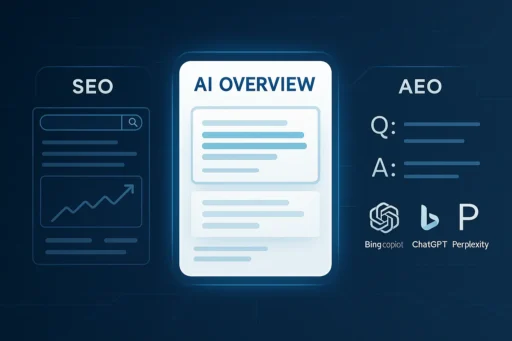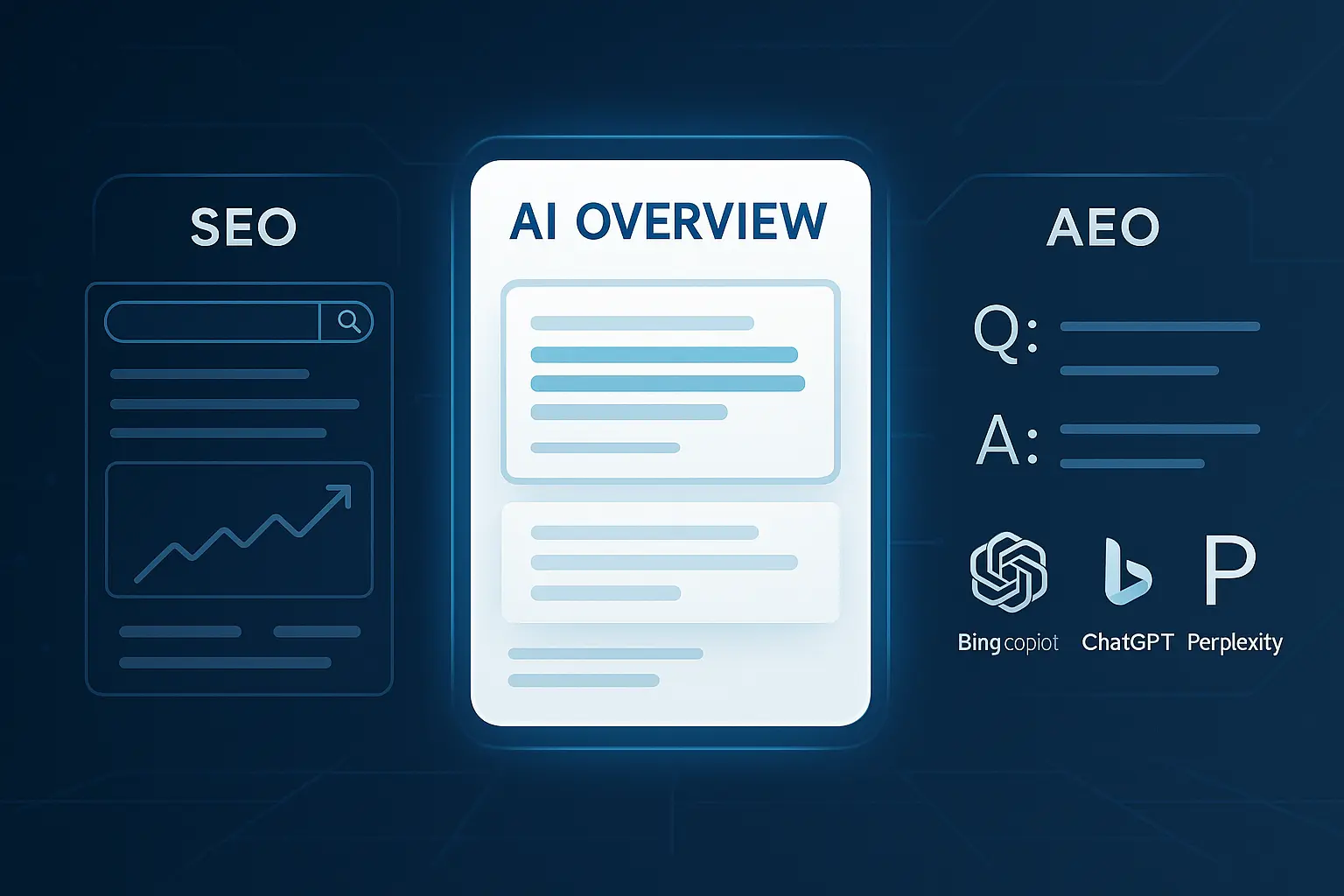In today’s fast-evolving digital landscape, businesses and marketers face a new challenge: ranking not only in traditional search results but also in AI-powered answer engines like Google’s AI Overview, Bing Copilot, ChatGPT, and Perplexity. These platforms are reshaping how users discover, consume, and trust online content. To stay competitive, it’s critical to understand the difference between AI Overview, SEO, and AEO, and how they interconnect.
This blog will break down each concept, highlight their unique roles, and provide actionable strategies to ensure your brand remains visible in both search results and AI-driven summaries.
Understanding the Basics
What is SEO?
Search Engine Optimization (SEO) is the practice of improving website visibility in traditional search engine results. It involves optimizing on-page elements (keywords, metadata, content), off-page signals (backlinks, authority), and technical performance (site speed, mobile-friendliness, indexing).
Key goals of SEO:
- Increase organic traffic from search engines.
- Improve keyword rankings.
- Build brand authority and trust.
👉 Example: Ranking a blog on “Best Rotisserie Packaging” on Google’s first page using optimized keywords, schema markup, and backlinks.
What is AI Overview?
AI Overview refers to AI-generated summaries or “snapshots” of search results. Google’s AI Overview (launched in 2024) pulls together information from multiple sources to present a concise, conversational answer directly in the search interface.
Why it matters:
- Users often read AI summaries instead of clicking links.
- Citations in AI Overview can drive significant referral traffic.
- Visibility depends on content accuracy, authority, and structure, not just keyword optimization.
👉 Example: If someone searches “What is the difference between SEO and AEO?”, Google’s AI Overview may show a combined summary citing top-ranking authoritative sources.
Read Also: AI Overviews: Everything You Need To Know As An SEO
What is AEO?
Answer Engine Optimization (AEO) is the practice of optimizing content for AI-powered answer engines (Google AI Overview, Bing Copilot, ChatGPT, Perplexity, etc.). While SEO focuses on ranking in results pages, AEO ensures your content is cited in AI-generated answers.
AEO strategies focus on:
- Structuring content with clear, factual answers.
- Using FAQ-style formats, lists, and schemas.
- Establishing authority through credible citations and expertise.
👉 Example: A travel blog structured with FAQs (“What is the best time to visit Ujjain?”) has higher chances of being cited in Google AI Overview and Bing Copilot summaries.
Key Differences Between AI Overview, SEO, and AEO
| Feature | SEO | AI Overview | AEO |
|---|---|---|---|
| Goal | Rank web pages in search results | Provide AI-generated summaries | Optimize for inclusion in AI-generated answers |
| Platform | Search engines (Google, Bing, Yahoo) | Google AI Overview (and similar) | AI-driven engines (Google, Bing Copilot, ChatGPT, Perplexity) |
| Optimization Focus | Keywords, backlinks, technical SEO | Content clarity & authority | Structured data, concise answers, trust signals |
| User Behavior | Users click results to explore | Users read summaries directly | Users rely on AI summaries but may click cited links |
| Content Format | Long-form, keyword-rich | Concise, reliable | FAQs, Q&A, schema, direct responses |
Why Businesses Need All Three
SEO is Still the Foundation
Without traditional SEO, your content won’t be indexed or ranked, making it invisible to both search engines and AI answer engines.
AI Overview is the Future of Search
Google’s AI Overview already appears in 65% of search queries (Search Engine Land, 2024). Brands that fail to adapt risk losing visibility as users shift to AI-driven discovery.
AEO is the Bridge Between the Two
Answer Engine Optimization ensures your brand stays visible in both traditional search and AI summaries, safeguarding organic reach in an evolving ecosystem.
Actionable Strategies for Success
1. Combine SEO + AEO for Maximum Impact
- Continue optimizing for keywords and backlinks (SEO).
- Format content into clear Q&A sections to be AI-citable (AEO).
2. Use Structured Data (Schema Markup)
- Implement FAQ schema, Breadcrumb schema, and Product schema to help AI engines extract clear answers.
- Example: A product schema for “Camphor Pods” makes it easier for Google AI Overview to pull pricing and features.
3. Optimize for AI Answer Engines Directly
- Create FAQ-rich blog posts.
- Include short, factual summaries within long-form content.
- Use trust signals (citations, author bios, references to reputable studies).
4. Monitor AI Citations
- Regularly check if your content is being cited in Google AI Overview or Bing Copilot.
- Use tools like Search Console AI Insights (beta) to track AI-driven traffic.
Final Thoughts
The future of digital visibility lies in mastering the balance between AI Overview, SEO, and AEO. SEO provides the foundation, AI Overview reshapes the search experience, and AEO ensures your brand is positioned within AI-generated answers.
Marketers who adapt early will not only maintain their rankings but also gain an edge in an era where AI-powered search dominates user behavior.
👉 In short: SEO gets you ranked, AI Overview gets you seen, and AEO gets you cited.





